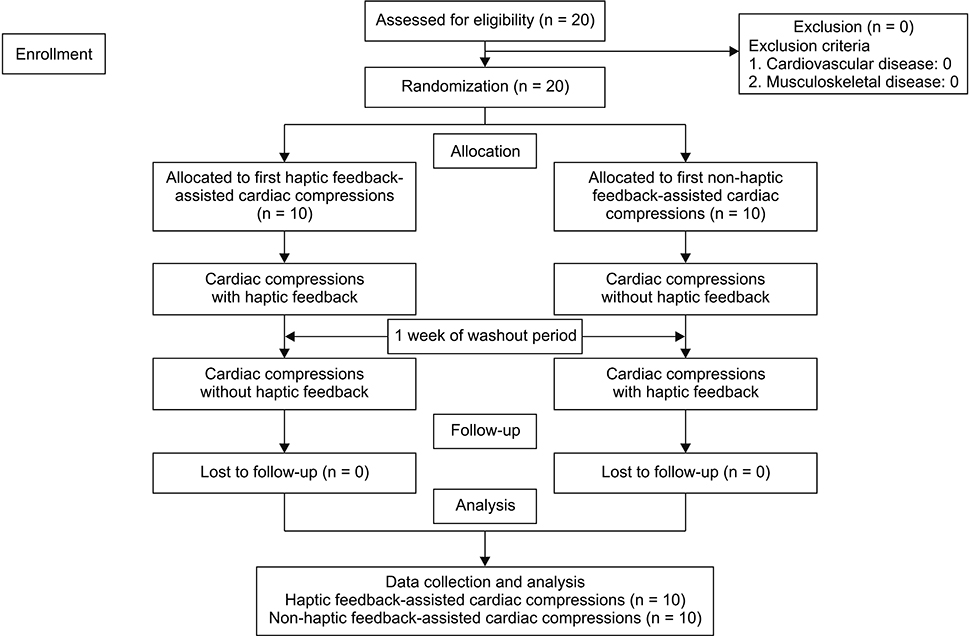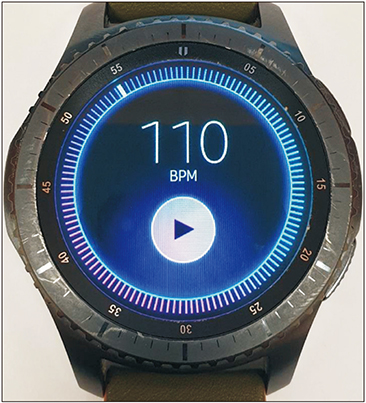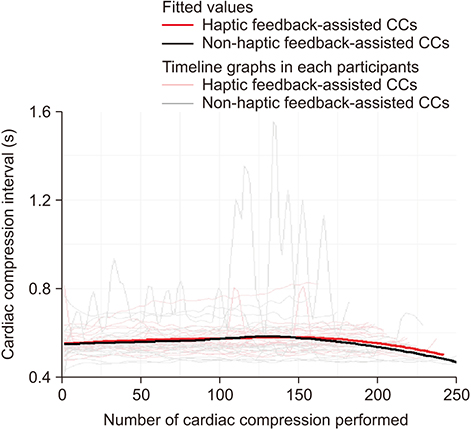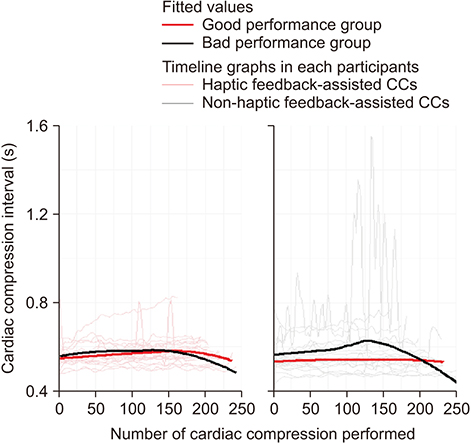Healthc Inform Res.
2019 Oct;25(4):274-282. 10.4258/hir.2019.25.4.274.
Effect of Watch-Type Haptic Metronome on the Quality of Cardiopulmonary Resuscitation: A Simulation Study
- Affiliations
-
- 1Department of Emergency Medicine, Samsung Medical Center, Sungkyunkwan University School of Medicine, Seoul, Korea. wc.cha@samsung.com
- 2Department of Digital Health, Samsung Advanced Institute for Health Sciences and Technology, Sungkyunkwan University, Seoul, Korea.
- 3Biostatistics and Clinical Epidemiology Center, Samsung Medical Center, Seoul, Korea.
- KMID: 2462225
- DOI: http://doi.org/10.4258/hir.2019.25.4.274
Abstract
OBJECTIVES
The aim of this study was to test the applicability of haptic feedback using a smartwatch to the delivery of cardiac compression (CC) by professional healthcare providers.
METHODS
A prospective, randomized, controlled, case-crossover, standardized simulation study of 20 medical professionals was conducted. The participants were randomly assigned into haptic-first and non-haptic-first groups. The primary outcome was an adequate rate of 100-120/min of CC. The secondary outcome was a comparison of CC rate and adequate duration between the good and bad performance groups.
RESULTS
The mean interval between CCs and the number of haptic and non-haptic feedback-assisted CCs with an adequate duration were insignificant. In the subgroup analysis, both the good and bad performance groups showed a significant difference in the mean CC interval between the haptic and non-haptic feedback-assisted CC groups"”good: haptic feedback-assisted (0.57-0.06) vs. non-haptic feedback-assisted (0.54-0.03), p < 0.001; bad: haptic feedback-assisted (0.57-0.07) vs. non-haptic feedback-assisted (0.58-0.18), p = 0.005"”and the adequate chest compression number showed significant differences"” good: haptic feedback-assisted (1,597/75.1%) vs. non-haptic feedback-assisted (1,951/92.2%), p < 0.001; bad: haptic feedbackassisted (1,341/63.5%) vs. non-haptic feedback-assisted (523/25.4%), p < 0.001.
CONCLUSIONS
A smartwatch cardiopulmonary resuscitation feedback system could not improve rescuers' CC rate. According to our subgroup analysis, participants might be aided by the device to increase the percentage of adequate compressions after one minute.
MeSH Terms
Figure
Reference
-
1. Abella BS, Alvarado JP, Myklebust H, Edelson DP, Barry A, O'Hearn N, et al. Quality of cardiopulmonary resuscitation during in-hospital cardiac arrest. JAMA. 2005; 293(3):305–310.
Article2. Eisenberg MS, Mengert TJ. Cardiac resuscitation. N Engl J Med. 2001; 344(17):1304–1313.
Article3. Rea TD, Crouthamel M, Eisenberg MS, Becker LJ, Lima AR. Temporal patterns in long-term survival after resuscitation from out-of-hospital cardiac arrest. Circulation. 2003; 108(10):1196–1201.
Article4. Daya MR, Schmicker RH, Zive DM, Rea TD, Nichol G, Buick JE, et al. Out-of-hospital cardiac arrest survival improving over time: Results from the Resuscitation Outcomes Consortium (ROC). Resuscitation. 2015; 91:108–115.
Article5. Feneley MP, Maier GW, Kern KB, Gaynor JW, Gall SA Jr, Sanders AB, et al. Influence of compression rate on initial success of resuscitation and 24 hour survival after prolonged manual cardiopulmonary resuscitation in dogs. Circulation. 1988; 77:240–250.
Article6. Meaney PA, Bobrow BJ, Mancini ME, Christenson J, de Caen AR, Bhanji F, et al. Cardiopulmonary resuscitation quality: [corrected] improving cardiac resuscitation outcomes both inside and outside the hospital: a consensus statement from the American Heart Association. Circulation. 2013; 128(4):417–435.
Article7. Kleinman ME, Brennan EE, Goldberger ZD, Swor RA, Terry M, Bobrow BJ, et al. Part 5: Adult basic life support and cardiopulmonary resuscitation quality: 2015 American Heart Association Guidelines Update for Cardiopulmonary Resuscitation and Emergency Cardiovascular Care. Circulation. 2015; 132(18 Suppl 2):S414–S435.8. Link MS, Berkow LC, Kudenchuk PJ, Halperin HR, Hess EP, Moitra VK, et al. Part 7: Adult advanced cardiovascular life support: 2015 American Heart Association Guidelines Update for Cardiopulmonary Resuscitation and Emergency Cardiovascular Care. Circulation. 2015; 132(18 Suppl 2):S444–S464.9. Perkins GD, Olasveengen TM, Maconochie I, Soar J, Wyllie J, Greif R, et al. European Resuscitation Council Guidelines for Resuscitation: 2017 update. Resuscitation. 2018; 123:43–50.
Article10. Wik L, Kramer-Johansen J, Myklebust H, Sorebo H, Svensson L, Fellows B, et al. Quality of cardiopulmonary resuscitation during out-of-hospital cardiac arrest. JAMA. 2005; 293(3):299–304.
Article11. Kirkbright S, Finn J, Tohira H, Bremner A, Jacobs I, Celenza A. Audiovisual feedback device use by health care professionals during CPR: a systematic review and meta-analysis of randomised and non-randomised trials. Resuscitation. 2014; 85(4):460–471.
Article12. Martin P, Theobald P, Kemp A, Maguire S, Maconochie I, Jones M. Real-time feedback can improve infant manikin cardiopulmonary resuscitation by up to 79%: a randomised controlled trial. Resuscitation. 2013; 84(8):1125–1130.
Article13. Oh J, Song Y, Kang B, Kang H, Lim T, Suh Y, et al. The use of dual accelerometers improves measurement of chest compression depth. Resuscitation. 2012; 83(4):500–504.
Article14. Yu BG, Oh JH, Kim Y, Kim TW. Accurate measurement of chest compression depth using impulseradio ultra-wideband sensor on a mattress. PLoS One. 2017; 12(8):e0183971.
Article15. Bhanji F, Donoghue AJ, Wolff MS, Flores GE, Halamek LP, Berman JM, et al. Part 14: Education: 2015 American Heart Association Guidelines Update for Cardiopulmonary Resuscitation and Emergency Cardiovascular Care. Circulation. 2015; 132(18 Suppl 2):S561–S573.16. Greif R, Lockey AS, Conaghan P, Lippert A, De Vries W, Monsieurs KG, et al. European Resuscitation Council Guidelines for Resuscitation 2015: Section 10. Education and implementation of resuscitation. Resuscitation. 2015; 95:288–301.
Article17. Chen KY, Ko YC, Hsieh MJ, Chiang WC, Ma MH. Interventions to improve the quality of bystander cardiopulmonary resuscitation: a systematic review. PLoS One. 2019; 14(2):e0211792.
Article18. Abella BS, Edelson DP, Kim S, Retzer E, Myklebust H, Barry AM, et al. CPR quality improvement during inhospital cardiac arrest using a real-time audiovisual feedback system. Resuscitation. 2007; 73(1):54–61.
Article19. Gruenerbl A, Pirkl G, Monger E, Gobbi M, Lukowicz P. Smart-watch life saver: smart-watch interactive-feedback system for improving bystander CPR. In : Proceedings of the 2015 ACM International Symposium on Wearable Computers; 2015 Sep 7-11; Osaka, Japan. p. 19–26.20. Ahn C, Lee J, Oh J, Song Y, Chee Y, Lim TH, et al. Effectiveness of feedback with a smartwatch for highquality chest compressions during adult cardiac arrest: a randomized controlled simulation study. PLoS One. 2017; 12(4):e0169046.
Article21. Song Y, Chee Y, Oh J, Ahn C, Lim TH. Smartwatches as chest compression feedback devices: a feasibility study. Resuscitation. 2016; 103:20–23.
Article22. Reeder B, David A. Health at hand: a systematic review of smart watch uses for health and wellness. J Biomed Inform. 2016; 63:269–276.
Article23. Lu TC, Chang YT, Ho TW, Chen Y, Lee YT, Wang YS, et al. Using a smartwatch with real-time feedback improves the delivery of high-quality cardiopulmonary resuscitation by healthcare professionals. Resuscitation. 2019; 140:16–22.
Article24. Lee J, Song Y, Oh J, Chee Y, Ahn C, Shin H, et al. Smartwatch feedback device for high-quality chest compressions by a single rescuer during infant cardiac arrest: a randomized, controlled simulation study. Eur J Emerg Med. 2019; 26(4):266–271.
Article25. Abella BS, Sandbo N, Vassilatos P, Alvarado JP, O'Hearn N, Wigder HN, et al. Chest compression rates during cardiopulmonary resuscitation are suboptimal: a prospective study during in-hospital cardiac arrest. Circulation. 2005; 111(4):428–434.
Article26. Song Y, Oh J, Chee Y. A new chest compression depth feedback algorithm for high-quality CPR based on smartphone. Telemed J E Health. 2015; 21(1):36–41.
Article27. Lundstrom R, Stromberg T, Lundborg G. Vibrotactile perception threshold measurements for diagnosis of sensory neuropathy: description of a reference population. Int Arch Occup Environ Health. 1992; 64(3):201–207.
- Full Text Links
- Actions
-
Cited
- CITED
-
- Close
- Share
- Similar articles
-
- Analysis of chest compression quality according to the metronome setting rate in metronome-assisted cardiopulmonary resuscitation
- Metronome Guided CPR to Improve the Quality of CPR
- Effect of Cardiac Arrest Team Training Using Script on the Quality of Simulated Resuscitation
- "Push Hard and Fast" Voice Prompt from AED Can Improve Quality of Chest Compression Performed by Untrained Lay People
- A Case of Metronome Pisa Syndrome in Risperidone Therapy





